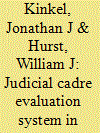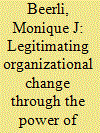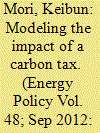|
|
|
Sort Order |
|
|
|
Items / Page
|
|
|
|
|
|
|
| Srl | Item |
| 1 |
ID:
176675


|
|
|
|
|
| Summary/Abstract |
Quantified goals for reducing energy consumption in buildings play a significant role in national and international energy policy. Calculations of potential energy savings from different interventions may be unreliable due to various types of uncertainty, resulting in a performance gap between predictions and actual energy consumption. Yet building energy policy continues to rely heavily on apparently robust calculations of energy savings, raising the question of why and how the policy process tolerates uncertainty and inaccuracy when quantification is its central logic. We describe a case study of the development of a new mandatory building energy standard, in which there is a lack of consensus on the energy it would save. We found that when this uncertainty was brought to light, the policy process raised other, unquantified logics in favour of energy efficiency measures. Using literature on calculation and expertise, we discuss how quantification is used in policy-making and how uncertainties are repressed, enabling the energy performance gap to persist. We conclude that broader awareness of the modes in which quantitative and other logics are used in energy policy, and a reframing of the types of energy savings to be made, may serve policy-making better than an illusion of calculative certainty.
|
|
|
|
|
|
|
|
|
|
|
|
|
|
|
|
| 2 |
ID:
145743


|
|
|
|
|
| Summary/Abstract |
Performance evaluation systems fundamentally shape the behaviour of Chinese judges, but scholarship on the concrete implementation of these institutions is scarce. Relying on nearly 15 months of fieldwork in six cities in China, we explain how the judicial cadre evaluation system, as unified by the 2011 “Guiding opinion of the Supreme People's Court,” has been implemented. Over 30 indices quantitatively measure Chinese courts’ “fairness” (gongzheng 公正), “efficiency” (xiaolü 效率) and “impact” (xiaoguo 效果), incentivizing court leaders to pressure their subordinate judges to resolve disputes as quickly as possible without unduly angering litigants or other actors. Under the hyper-quantified conditions of cadre evaluation, systemic praising and shaming bring about what we call “intra-state legibility,” which leads to a variety of informal worker reactions to these tactics. This study not only uses interviews and new documentary evidence to add necessary detail to our understanding of cadre evaluation systems, it also engages debates in comparative law and politics regarding bureaucratic influence on authoritarian judicial behaviour.
|
|
|
|
|
|
|
|
|
|
|
|
|
|
|
|
| 3 |
ID:
155688


|
|
|
|
|
| Summary/Abstract |
While humanitarian work has always implied a certain level of risk, in the last two decades there has been a growing concern that humanitarian and peacekeeping agents are exposed to unprecedented levels of insecurity. To determine whether or not such claims and perceptions are substantiated, researchers have developed quantitative datasets aimed at measuring and tracking threats to humanitarians and peacekeepers at the global level. In contrast to humanitarian practitioners which use such quantitative expertise to suggest aid work is becoming increasingly dangerous, the producers of quantitative representations of humanitarian security suggest instead that attack rates have remained for the most part fairly stable despite increases in absolute numbers. In order to make sense of this paradox, this article draws on neo-Bourdieusian approaches, the sociology of professions and organizations, as well as global governance literature on quantification to suggest that such inconsistencies relate to the use of quantitative data to legitimate organizational change and bureaucratic restructurations in relation to the institutionalization of security expertise. By understanding the dynamics of organizational change, this article sheds light on one of the ways through which international humanitarianism and peacekeeping is shifting from a paradigm of proximity to a paradigm of distance and remoteness.
|
|
|
|
|
|
|
|
|
|
|
|
|
|
|
|
| 4 |
ID:
115161


|
|
|
|
|
| Publication |
2012.
|
| Summary/Abstract |
In recent years, energy policy makers have proposed a carbon tax as an economy-wide policy tool to curb greenhouse gas (GHG) emissions. The quantification of its impact on GHG emissions has relied on an energy-economy model, whose complexity often makes it difficult to comprehend how it simulates the interaction of a carbon tax and energy demand. This study therefore aims at developing an alternative model called the Carbon Tax Analysis Model (C-TAM). The elasticity-based approach used in C-TAM is less sophisticated than an equilibrium-based approach used in an energy-economy model, but C-TAM is designed to maximize its predictive capabilities by using a wide range of elasticities for each sector and fuel use, accounting for likely changes in fuel mix for electricity generation, and addressing the model's sensitivity to elasticity estimates with Monte Carlo simulation. The trial analysis in this study evaluates a potential carbon tax in Washington State, suggesting a carbon tax at US$30 per metric ton of CO2 (tCO2) lowers GHG emissions by 8.4% from the business-as-usual (BAU) scenario in 2035. The study concludes that C-TAM can provide meaningful policy implications by forecasting detailed impact on revenues and energy demand for each sector and fuel use.
|
|
|
|
|
|
|
|
|
|
|
|
|
|
|
|
| 5 |
ID:
151675


|
|
|
|
|
| Summary/Abstract |
Conflict, crime, development, security, human rights, and democracy, to name a few, are all examples of subjects that have been delimited and constructed in the form of databases and sets of quantitative indicators. While the state had traditionally held the exclusive monopoly of quantified production, today many actors participate in its fabrication and circulation, sometimes even working on the same theme. Taking the example of humanitarian security, this article argues for the need to investigate the factors that structure a researcher and a research center's choice to develop new areas of quantitative research. Giving an account of who has the power to count and calling into question the disinterested production of data, this article also points to the wider power effects of transforming insecurity into quantified measures
|
|
|
|
|
|
|
|
|
|
|
|
|
|
|
|
| 6 |
ID:
151672


|
|
|
|
|
| Summary/Abstract |
The articles in this special section argue that, by looking at quantification as a technical and political technique of power, we can effectively engage with newly established types of transnational power and better understand how numbers can enable reconfigurations and hence reorderings of power relations. The section looks at how numbers, in the form of risk assessments, measuring for results, and governance indicators, have a crucial impact in current transnational politics, which in turn influences resource allocation and recognition, discourses on undesirable individuals, possibilities for political leverage, and potential ownership.
|
|
|
|
|
|
|
|
|
|
|
|
|
|
|
|
| 7 |
ID:
151674


|
|
|
|
|
| Summary/Abstract |
The fragile states agenda has recently converged with the so-called culture of measuring for results, creating standards often seen by critics as donor driven. The newly established Sustainable Development Goals now invite a data revolution that can see yet more intense practices of quantification. Nevertheless, this article argues such practices can be widening windows of opportunity for change. It looks at the g7+ group of self-labeled fragile states and its tools for self-measurement. These tools closely resemble mainstream quantification, but also bring key contributions. In fact, direct opposition on the part of fragile states is perhaps as possible as it once was for the so-called Third World; on the other hand, the article suggests subtle power can perhaps be countered by subtle change.
|
|
|
|
|
|
|
|
|
|
|
|
|
|
|
|
|
|
|
|
|